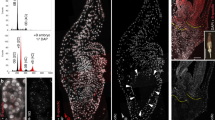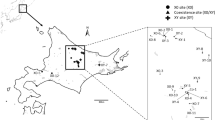Abstract
GIANT chromosomes have recently been found in different cells in the ovule of some Angiosperms1–3. The homologues are not paired and they have a granular structure without distinct bands, thus differing from the characteristic salivary gland chromosomes of Chironomus or Drosophila. They are more comparable with the primary polytene chromosomes in the ovary of Calliphora4,5, or the salivary gland chromosomes of Dasyneura6. In Phaseolus coccineus the single giant chromosomes could only be identified in the suspensor cell nuclei, because of the uniformity of euchromatic and heterochromatic regions7–9. In the Diptera the appearance of distinct bands sometimes depends on a low breeding temperature4,10–12, and so we have investigated the influence of temperature on the structure of giant chromosomes in the Angiosperm Phaseolus vulgaris, which is known to have giant chromosomes in the suspensor cell nuclei similar to those described for Phaseolus coccineus. The plants, however, are smaller, fast growing, and self pollinating, and therefore readily cultivated in phytotrons.
This is a preview of subscription content, access via your institution
Access options
Subscribe to this journal
Receive 51 print issues and online access
$199.00 per year
only $3.90 per issue
Buy this article
- Purchase on Springer Link
- Instant access to full article PDF
Prices may be subject to local taxes which are calculated during checkout
Similar content being viewed by others
References
Nagl, W., Naturwissenschaften, 49, 261 (1962).
Tschermak-Woess, E., Protoplasmatologia, 1 (Springer, Wien, 1963).
Geitler, L., Forsch. Fortschr., 39, 295 (1965).
Bier, K., Z. Naturforsch., 13 b, 85 (1958).
Bier, K., Chromosoma, 11, 335 (1960).
Matuszewski, B., Chromosoma, 16, 22 (1965).
Nagl, W., Osterr. Bot. Z., 109, 431 (1962).
Nagl, W., Chromosoma, 16, 511 (1965).
Nagl, W., Osterr. Bot. Z., 114, 171 (1967).
Ribbert, D., Chromosoma, 21, 296 (1967).
Wolf, B. E., Chromosoma, 8, 396 (1957).
Wolf, B. E., Chromosoma, 13, 646 (1963).
Pelling, C., Chromosoma, 15, 71 (1964).
Pavan, C., in Genetic Control of Differentiation, 222 (Brookhaven Nat. Lab., New York, 1965).
Berendes, H. D., Chromosoma, 24, 418 (1968).
Author information
Authors and Affiliations
Rights and permissions
About this article
Cite this article
NAGL, W. Banded Polytene Chromosomes in the Legume Phaseolus vulgaris. Nature 221, 70–71 (1969). https://doi.org/10.1038/221070b0
Received:
Issue Date:
DOI: https://doi.org/10.1038/221070b0
This article is cited by
-
Polyteny: still a giant player in chromosome research
Chromosome Research (2017)
-
Ploidy level determination within the context of in vitro breeding
Plant Cell, Tissue and Organ Culture (PCTOC) (2011)
-
Localization of phaseolin genes in the polytene chromosomes ofPhaseolus coccineus (Leguminosae)
Genetica (1990)
Comments
By submitting a comment you agree to abide by our Terms and Community Guidelines. If you find something abusive or that does not comply with our terms or guidelines please flag it as inappropriate.



